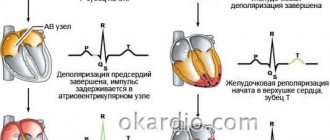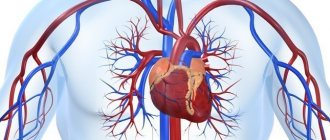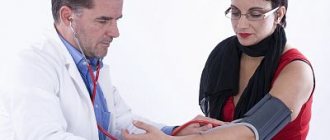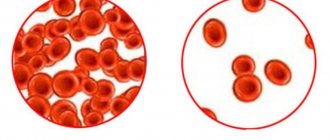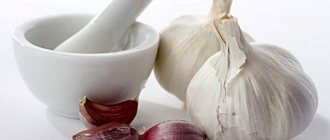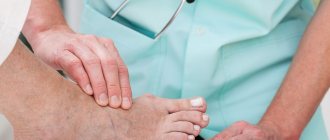Is it so scary and does it need to be treated?
- In the generally accepted sense, hypotension is if the tonometer shows you numbers below 90\60 mmHg. But everyone has their own blood pressure standards and there is no need to “treat the numbers” if there are no complaints.
- Sometimes low blood pressure can still mean that the brain and other vital organs are suffering from a lack of blood flow. What symptoms may appear?
- Dizziness, feeling of unsteadiness
- Sudden loss of consciousness
- Foggy, blurred vision
- Changes in heart rate
- Nausea (no vomiting!)
- General weakness, difficulty concentrating
Hypotension. What to do?
Everyone knows what hypertension and hypertensive crisis are. But less is known about hypotension - low blood pressure, although many suffer from hypotension.
Hypotonic disease is a condition of the body characterized by a decrease in arterial tone. This disease is characterized by a decrease in systo- logical pressure below 100 mmHg, and diastolic pressure below 60 mm. Hg Art.
Hypotension can be caused by nervous conditions; chronic fatigue caused by an imbalance in the ratio of hours of rest and work; depression and other apathetic and depressed states; some infections; diseases of the cardiovascular system; adrenal gland diseases; phlebeurysm.
Symptoms of hypotension
- general weakness;
- rapid fatigue during physical and mental stress;
- headaches, dizziness, chilliness of the extremities, tendency to faint;
- feeling of lack of air, insomnia;
- pain in the heart, heaviness in the stomach, loss of appetite;
- Often there are disturbances in stool (usually constipation), irregularities in the menstrual cycle in women and decreased potency in men.
Treatment of hypotension
Hypotension is a serious disease and you should not self-medicate here! The most commonly used and effective drugs in this case are ginseng, immortelle, hawthorn and eleutherococcus tinctures. These, like all drugs, affect each person differently, so any herb can cause a negative reaction and worsen your condition. The doctor you need to contact is a cardiologist, he will do a full examination, determine the cause and prescribe exactly the drugs that are suitable for you based on the history of all your previous diseases.
There are several options for dealing with low blood pressure. 1. Water. Hypotensive people need to drink 2-3 glasses more per day than you usually drink. This will allow you to feel at your level and maintain normal blood pressure. 2. Sleep. Rest should be about 9-10 hours. This amount of time will help you restore the energy you spent during the day. 3. Active recreation and walking. Movement is life. Play sports without heavy loads, but regularly. The best medicine is walking, swimming, outdoor games. All our movements improve blood circulation, it moves through the vessels, makes all the organs of the body work and therefore improves overall physical condition. 4. Shower. A contrast shower is very useful, as it improves the condition of blood vessels. Pouring cold water, bath, sauna, massage, etc. But the bath, as you know, is a serious matter and hypotensive people should approach it carefully and gradually. You can’t change the temperature frequently: from cold to hot. You may lose consciousness. 5. A person with low blood pressure should not get out of bed suddenly. A sudden rise can also cause loss of consciousness. 6. Massage and physical therapy for hypotension strengthen the body, improve the functioning of the cardiovascular, nervous (regulating blood circulation), muscular systems, metabolism, and help learn how to correctly alternate between relaxation and muscle contraction.
7. Nutrition for hypotension should be healthy, without special dietary restrictions, and include in the diet: vegetables, especially fresh green ones, in large quantities, whole grains, legumes, high-quality fats, sea fish, eggs, chicken, dairy products from goat milk, fruits, unroasted nuts and seeds.
With low blood pressure, a crisis can also develop - only a hypotonic one: this is a sharp decrease in blood pressure, which leads to insufficient blood supply to the brain, manifested by a sudden deterioration in a person’s condition: fainting, dizziness, weakness.
How to help the victim?
- The patient should be placed on a bed or other horizontal surface. Place a pillow or blanket under your shins; your legs should be slightly higher than your head. This leads to increased blood flow to the brain and rapid restoration of consciousness.
- Tight clothing should be loosened.
- It is very important to ensure a flow of fresh air into the room.
- Warm the patient by covering him with a warm blanket or blanket.
- Give the victim hot, sweet, strong tea, adding 10-15 drops of tincture of eleutherococcus, ginseng, Chinese lemongrass, pantocrine, zamanikha or other general tonic drugs.
- Measure blood pressure and record blood pressure readings and time. During the first hour, monitor the pressure every 15 minutes, then the interval can be increased to 30 minutes to an hour.
If blood pressure steadily decreases and the victim loses consciousness, call an ambulance. If the condition improves, you can limit yourself to calling a local therapist. Especially if this was the first such episode and the cause of hypotension is not yet clear.
The most reliable method of combating hypotension is still working together with a specialist. Therefore, there is nothing more reliable than scheduling a consultation with professionals.
Fedorova Lyubov Alekseevna – therapist, first category doctor, medical cardiologist.
Let's look at the possible causes of low blood pressure.
Many daily non-pathological (!) factors lead to a decrease in this indicator:
- Usually in the morning the pressure is lower than in the evening, and it can vary within 30-40 units and this is normal.
- If you are pregnant, your blood pressure may be low due to blood redistribution
- If you stand on your feet for a long time or, conversely, lie in bed for a very long time (this is especially noticeable in those who have been on long-term bed rest), the pressure will decrease due, again, to the redistribution of blood and its stagnation in the lower extremities
- If you are frozen, your pulse slows down and your blood pressure drops.
- Hypotension due to a sudden change in body position, or postural (for example, quickly jumping out of bed or abruptly getting up from the sofa). This is accompanied by dizziness, darkening of the eyes, tinnitus, general weakness, and sometimes fainting and goes away within a few minutes. It may also occur for the first time and more often in old age due to the fact that the elasticity of the vascular wall is lost with age. In addition, it can also occur after intense physical activity.
- Hypotension after eating (or postprandial). Yes, yes, after eating! The thing is. that after a hearty, hearty lunch or dinner, a large amount of blood flows to the digestive organs so that food is digested faster. Blood is redistributed in the body, the pulse quickens and blood pressure may drop. Mostly, such conditions occur in older people, especially those with hypertension, people with Parkinson's disease and diabetes.
- If you are taking certain medications, for example, to treat hypertension, some antidepressants, muscle relaxants. Never self-medicate!
- Some researchers believe that low blood pressure is genetically determined. If your parents have hypotension, it is likely that you have inherited this feature.
Herbal tinctures, infusions, decoctions for hypotension
Alcohol tinctures
Zamanika herb, ginseng roots, Rhodiola rosea, Leuzea, Eleutherococcus are famous for their ability to stimulate the central nervous system. Alcohol-based tinctures of these plants have a beneficial effect on the general condition of a person and help increase blood pressure in the vessels. These drugs are prepared industrially and sold in pharmacies. Doctors prescribe them to prevent hypotension.
Alcohol tinctures of ginseng, ginseng, and eleutherococcus are contraindicated for pregnant and lactating women and children under 12 years of age. They should not be used for a long time. If you take them continuously for several months, the opposite effect will occur. A person suffering from hypotension will experience headaches and nervousness. He may develop tachycardia, attacks of nausea and vomiting.
When taking alcoholic tinctures of medicinal herbs, the dosage should be observed: no more than 40 drops of the drug per half glass of liquid. Use it as recommended by a doctor 2-3 times a day before meals. The interval is at least half an hour.
Water infusions, decoctions
St. John's wort is one of the most useful medicinal herbs. Traditional medicine knows recipes that can successfully cope with low blood pressure. A simple way to prepare St. John's wort infusion is as follows:
- 30 g of dry raw materials are mixed with 1 liter of boiling water;
- Cover the container with a lid and leave for 3.5 hours;
- The finished infusion is filtered and placed in a cool, dark place.
- drink it in the morning and evening, 0.5 cups.
A decoction of the herb St. John's wort has beneficial properties. Dry raw materials – 1 tbsp. – pour into a glass of water, put on fire and cook over low heat for 15 minutes. The strained broth is drunk throughout the day.
Thistle is a herb, the use of which in an infusion helps to increase blood pressure. The product acts quickly and effectively. It is made from 20 g of dry grass and 200 ml of boiling water. Leave for 15-20 minutes and take half a glass 4 times a day.
Dry immortelle herb has the properties of stabilizing blood pressure during hypotension. A ready-made infusion of 10 g of raw material per glass of water is consumed in drops twice a day before meals. For one dose, you need to dilute 30 drops of the composition in 200 ml of liquid.
Rhodiola rosea is one of the plants that has a positive effect in the prevention and treatment of hypotension. It calms, tones, stops bleeding. It is used to restore strength and muscle activity. All parts of Rhodiola rosea are used as raw materials. The root of the plant is especially often used. Out of him
They make tinctures with alcohol, water infusions and decoctions.
Homemade alcohol tincture is prepared as follows:
- dried and powdered roots - 10 g - pour 2 tbsp. vodka;
- The container is closed, placed in the far corner of the cabinet and kept for 21 days.
Take it carefully, observing the dosage: 30 drops per 0.5 glass of water.
A healthy decoction is prepared from the root of Rhodiola rosea: a teaspoon of the prepared raw material is poured into 0.5 liters of liquid and brought to a boil, simmered for 15 minutes, filtered and consumed in the morning, afternoon and evening, 1 tbsp. before meals.
For aqueous infusions, the upper part of the plant is used.
Leuzea is a herb whose root has healing powers. An extract is produced from it, which is widely used for the prevention and treatment of hopenesia and other diseases. The plant can improve general physical condition, restore loss of strength, eliminate drowsiness and apathy. It is added to various drinks. Pharmaceutical preparations containing alcohol are taken according to generally accepted methods. At home, an infusion is prepared from Leuzea root: 3 tbsp. of raw materials, pour 1 liter of boiling liquid, leave for 15-20 minutes, pour into a storage container and take 1 tbsp three times a day.
Fees
Herbal infusions have an excellent effect on increasing blood pressure. The best combination is considered to be St. John's wort, chamomile, and stinging nettle. They are taken in equal parts. From 2 tbsp. The mixture is prepared as an infusion, which is taken half a glass in the morning and evening.
Another collection based on St. John's wort includes Rhodiola rosea and vitamin supplements: rose hips or hawthorn berries. For 400 ml of boiling water take 1 tbsp. St. John's wort herb, 2 tbsp. remaining ingredients. This drink has a good effect on the functioning of the heart and blood vessels and normalizes blood circulation.
Herbal infusions and teas can increase and maintain normal blood pressure and maintain overall physical well-being. The main component is raw materials purchased from a pharmacy. It is certified and guaranteed to be collected from environmentally friendly areas.
Diagnosis of hypotension
The main goal of diagnosis is to establish the presence of the disease itself and the conditions that caused it. To make a correct diagnosis, blood pressure is measured three times (an interval of three to five minutes). Daily monitoring of blood pressure is also carried out, aimed at determining fluctuations in value and circadian rhythm.
To exclude or confirm the presence of secondary arterial hypotension in a patient, a comprehensive examination of the nervous, endocrine and cardiovascular systems is necessary. The results used for this are:
- biochemical blood test (glucose, electrolytes, lipid fractions, cholesterol);
- electrocardiograms (with stress tests and at rest);
- echocardiography;
- electroencephalography;
- orthostatic test.
Patients with hypotension are advised to consult doctors: a neurologist, cardiologist, endocrinologist and ophthalmologist.
How to increase low blood pressure with folk remedies
There are many simple ways to quickly increase low blood pressure using folk remedies.
- take a contrast shower;
- drink a cup of coffee or sweet strong tea;
- drink a few glasses of water;
- massage your feet and temples clockwise for 2-3 minutes.
Buy Eleutherococcus (root) on our website
These folk remedies for low blood pressure are good if there is a sharp drop in levels. And to achieve a mild and persistent increase in blood pressure, 5 medicinal herbs will help:
- tansy;
- lemongrass;
- ginseng;
- Eleutherococcus;
- Bay leaf.
In addition, for low blood pressure, cinnamon, dark chocolate, and green tea are suitable for treatment with folk remedies.
Healthy drinks
Black tea takes first place. Doctors and physiotherapists agreed that such a drink would be beneficial for hypotensive patients.
Useful properties of the drink:
- dilates blood vessels;
- provides brain cells with oxygen;
- increases blood pressure;
- cleanses of toxins;
- eliminates neuroses;
- prevents the development of atherosclerosis.
For hypotensive people, pour 1 tsp with a glass of boiling water and leave for 5 to 10 minutes. You should not prepare for future use.
Treatment of hypotension with folk remedies
will be very useful for hypotension . Experts believe that a drink made from green leaves does not lower blood pressure due to their high caffeine content.
Beneficial features:
- normalizes the condition of blood vessels;
- stimulates brain activity;
- increases blood pressure;
- strengthens the immune system;
- accelerates digestive processes;
- has a beneficial effect on the nervous system;
- participates in metabolism;
- cleanses the body of toxins;
- diuretic.
To increase blood pressure 1 tsp. Brew with a glass of boiling water and leave for 7 minutes.
Treatment of low blood pressure in women with folk remedies
The fair sex suffers from hypotension, subjecting themselves to diets and intense physical activity, trying to meet beauty standards, or during pregnancy or menopause. Whatever the symptoms and causes of low blood pressure in women, treatment should include the use of folk remedies.
The most popular treatment for low blood pressure in women is flax seeds. They must be consumed on an empty stomach. The following products are also suitable for the fair sex:
- cinnamon decoction;
- essential oils of clove and rosemary;
- bitter chocolate;
- fireweed and green tea.
Worth remembering! You can raise your blood pressure if you buy the “Monastery Tea” collection. Clean vessels."
Sudanese rose petals
Hibiscus tea for hypotension is a drink for real gourmets. It represents the petals of the Sudanese rose, which gives it a red color and a sour taste. The drink is good both hot and cold. The only question that remains controversial is whether to drink hot or cold tea for hypotension . Doctors recommend drinking this drink hot with added sugar.
Sudanese rose has the following beneficial qualities:
- increases immunity;
- has a rejuvenating effect;
- removes toxins from the body;
- stabilizes blood pressure.
Method of preparation: 1 tsp. pour rose petals into a glass of hot water. Let it brew for 5 minutes.
Scientists have come to the conclusion that hibiscus in large quantities reduces blood pressure, so hypotensive people should not get carried away with this drink. The recommended amount of drinking Sudanese rose drink is 1 glass per day.
